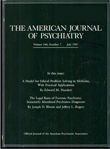Seasonality of symptoms in women with late luteal phase dysphoric disorder
Abstract
OBJECTIVE: Both late luteal phase dysphoric disorder (LLPDD) and seasonal affective disorder are cyclical disorders often manifested by "atypical" depressive features. The goal of this study was to determine whether patients with LLPDD demonstrate substantial seasonal variation in symptoms. METHOD: Consecutive female patients attending a subspecialty clinic in a university teaching hospital were assessed by means of DSM-III-R criteria. All subjects completed the Seasonal Pattern Assessment Questionnaire, modified to include items on the seasonality of premenstrual symptoms. The results were compared with those of a group of female nonclinical subjects (N = 50). RESULTS: One hundred patients met the DSM-III-R criteria for LLPDD. Compared to the nonclinical group, the LLPDD patients had a significantly higher mean global seasonality score (an index of seasonality of mood and vegetative symptoms) and a significantly higher rate of seasonal affective disorder (38% versus 8%) as determined by Seasonal Pattern Assessment Questionnaire criteria. Twenty-five percent of the LLPDD group rated their seasonal variation in premenstrual symptoms as marked or severe, while 30% considered seasonal changes in overall symptoms to be a marked or severe problem. CONCLUSIONS: These results suggest that patients with LLPDD have substantial seasonal patterns in mood and premenstrual symptoms. These seasonal patterns have implications for the clinical assessment and treatment of LLPDD. For example, light therapy may be beneficial for women with seasonal worsening of LLPDD.



